| For decades, Bass
Lake (sometimes called "East Bass") on Highway C in
Florence County, Wisconsin, was a slow-no-wake body of
water. |
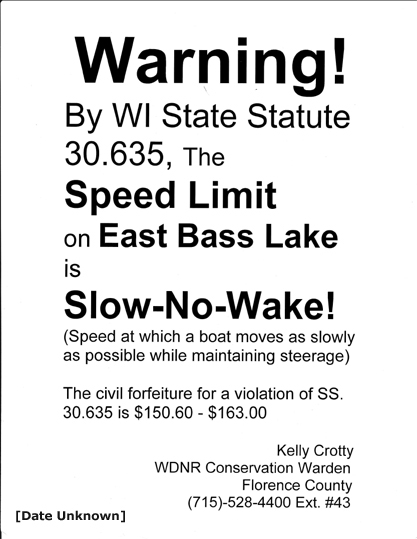
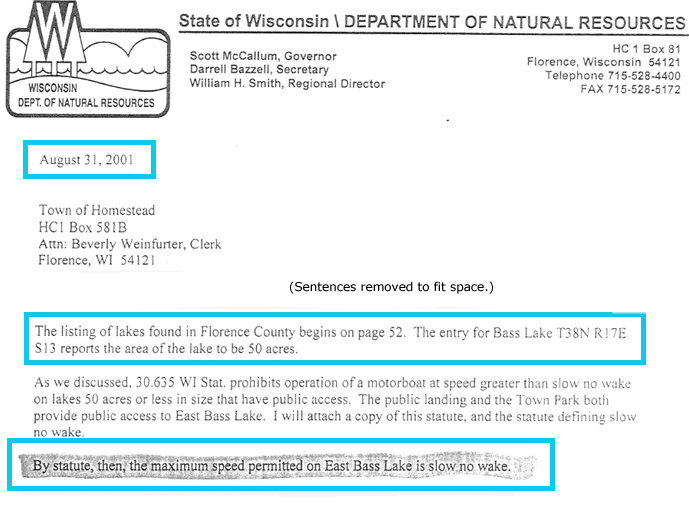
| Some
years ago I noticed motor boats and jet skis on Bass and
stupidly assumed the law had changed, and they were now
permitted even on small lakes. At the annual Homstead
Protective Association meeting in July 2014, however, a
resident commented that he couldn’t understand why all
the fast-moving powered craft were on the lake—he
thought it was supposed to be slow-no-wake. That comment motivated me to identify and send an e-mail to Warden Kelly Crotty; Bass is in his jurisdiction. He replied that the lake was "49.7 acres" (just under slow-no-wake cutoff of 50 acres). “…but…” he continued, “...a DNR employee in Madison advised a lake riparian owner that the state would allow above Slow-No-Wake activity due to the size being very close to 50.” |
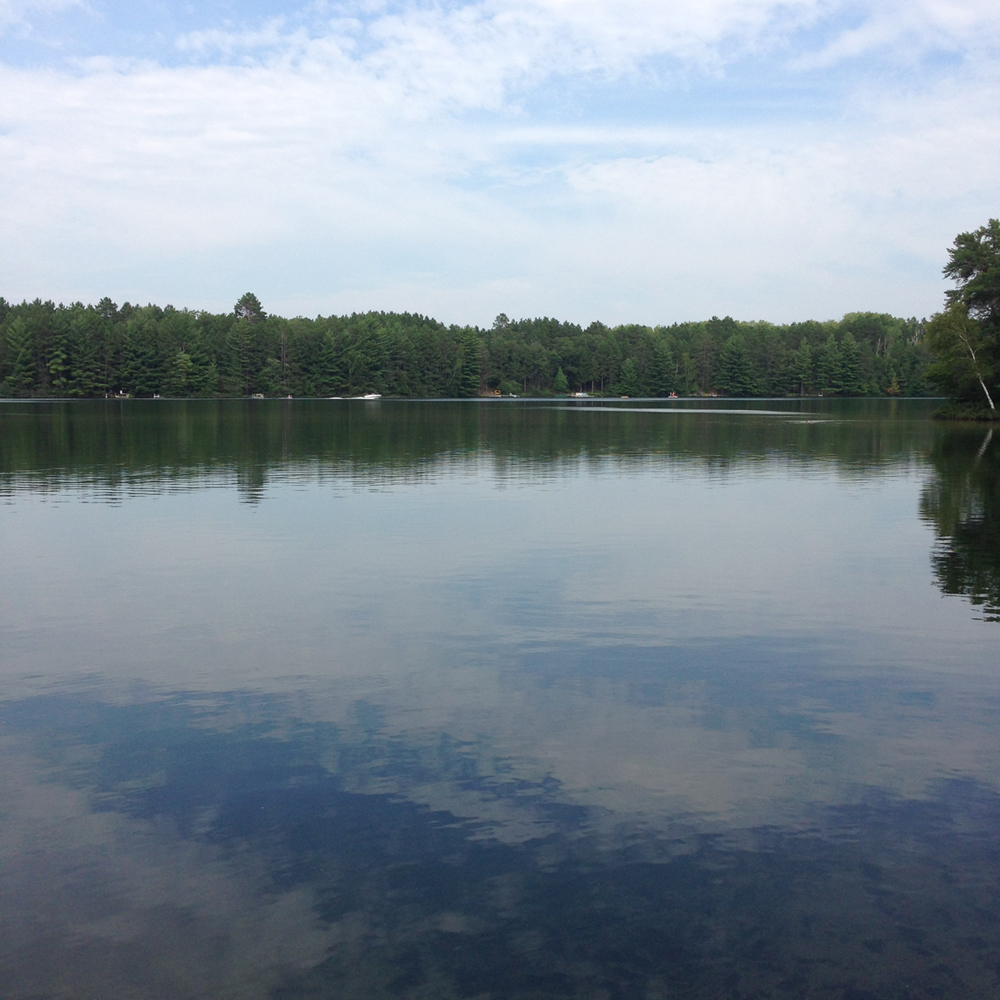
|
I decided Crotty
wasn’t doing his job, so I contacted higher level DNR
managers thinking they would reprimand Crotty and make
sure he enforced the lake's slow-no-wake status.
Instead, the DNR’s Bureau of Water Quality, led by
Carroll Schaal, quickly re-measured the lake and
discovered that its previous finding of 49.7 acres was
wrong.
DNR
Measurement
Bass Lake was 50.554842 acres Schaal said, slightly more than 1/20 of an acre above the 50.49-acre cutoff below which the acreage would be rounded to 50 and the lake’s slow-no-wake status preserved. The new measurement was based on the ArcMap image below produced by DNR GIS Analyst Dennis Weise, who said his measurement was plus or minus one acre in terms of accuracy. |
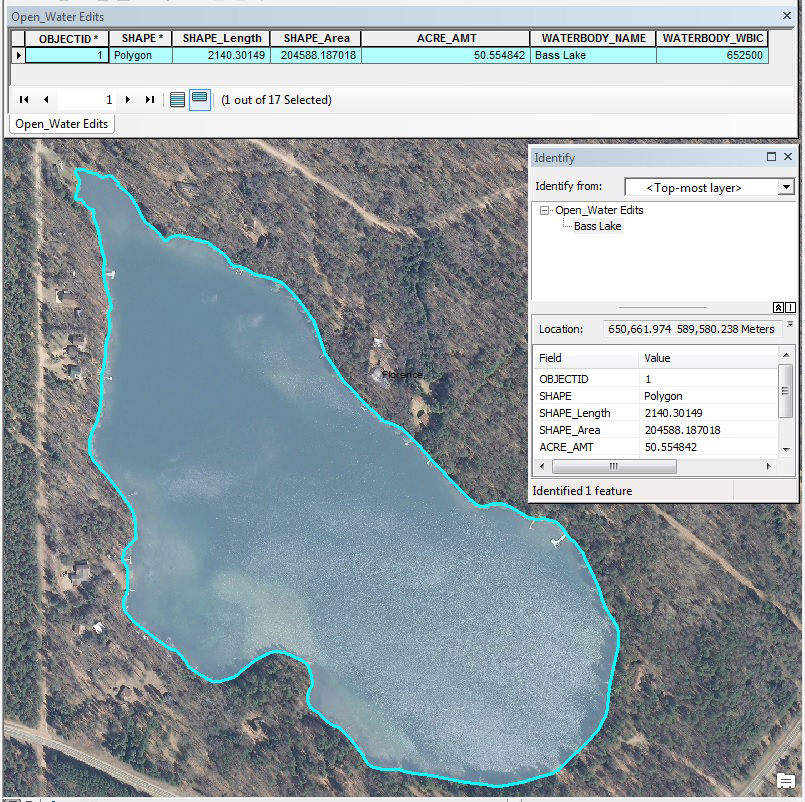
The 50.55-acre
measurement of Bass Lake Weise obtained
is only the latest DNR effort.
Below are some
earlier ones. (About the first on the list, DNR
Conservation Warden Supervisor Thomas W.
Wrasse [now retired] stated in an e-mail: "The one
that does exist showing 55.5 acres
was not done by any of the accepted methods of
measurement that exist today.")
1. Wisconsin Conservation Department Biology Division July 1941—55.5 acres; 2. DNR Warden letter August 31 2001: ”...Wisconsin Lakes...a DNR publication...reports the area of the lake to be 50 acres”; 3. Town of Homestead town board meeting minutes July 31, 2003—"...DNR apparently changed the acreage of the lake down to 49.5 acres”; 4. DNR employee 1. e-mail 8-20-2014: "Hello—My Wisconsin Lakes book lists it at 50 acres. A 1971 DNR publication lists it as 49.7 acres”; 5. DNR employee 2. e-mail 8-20-2014: “East Bass is 49.7 acres…”; and 6. September 30, 2014 listing at http://dnr.wi.gov/lakes/lakepages Results.aspx—48 acres. Consultant
Measurements
To check Weise's
measurement, I hired two ArcMap consultants, not
telling either about the other or why I wanted the
lake measured. The first was
Cason & Associates (http://casonassociates.com),
Berlin, Wisconsin. It produced the ArcMap image
below and found Bass Lake to be 49.07 acres, more then
1 acre below the DNR measurement; the consultant also
stated the measurement was accurate and did not need a
plus-minus error range.
|
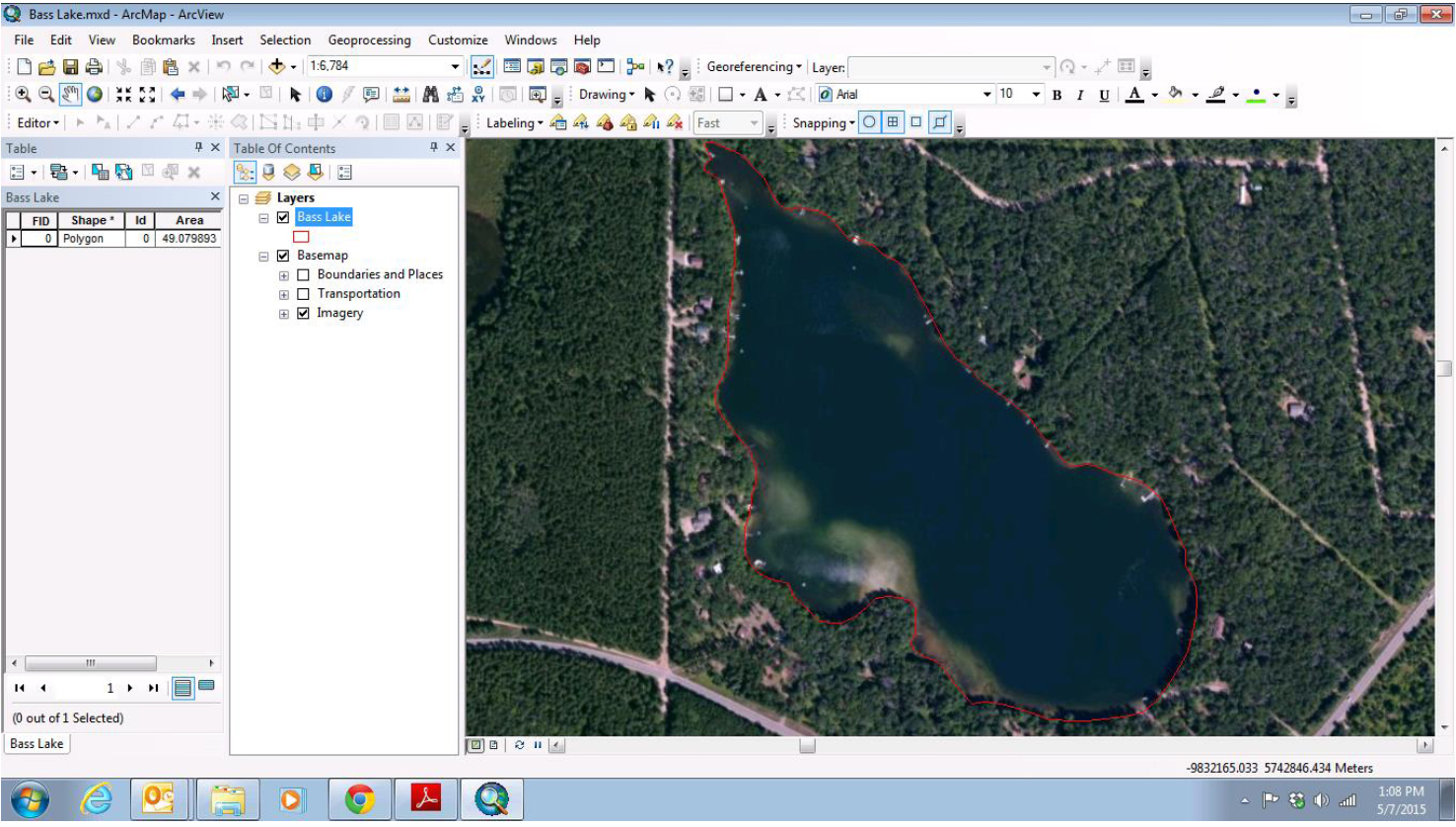
| Next,
I
hired Mapping Specialists, Limited
(http://www.mappingspecialists.com), Fitchburg,
Wisconsin. Its ArcMap analysis of Bass (below) found
the lake to be 49.18 acres. Mapping Specialists,
too, stated the measurement was accurate and did not need
a plus-minus error range. The two
consultant measurements (49.07 and 49.18) are about 1/10
acre apart from each other but more than 1.3 acres below
the DNR's 50.55 measurement. |
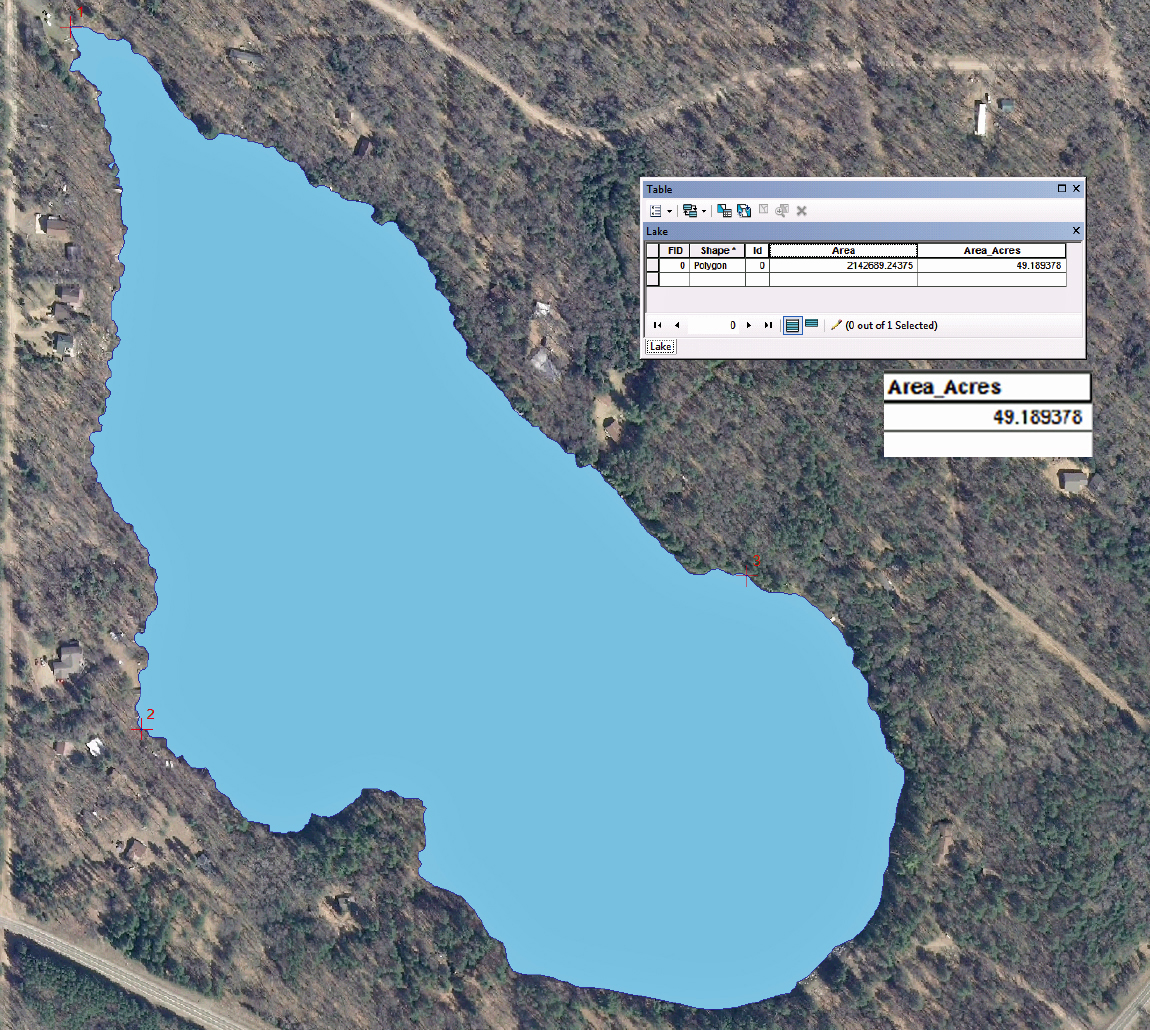
| Using
Photoshop
Elements to superimpose the Mapping Specialists, Limited
effort over the DNR's (below), it's easy to see how much
land the teal outline includes. I paid the MS
consultant to analyze the DNR measurement without
telling him who did it and he stated in an e-mail:
"I took a look at the image you sent, and I have compared it to the one I sent to you. It looks to me like whoever did this measurement was very generalized in their approach. You can see the change in detail between what I did (red) and the other measurement (teal). There is a lot of land along the shore that would have added to that 50.6 acre measurement." |
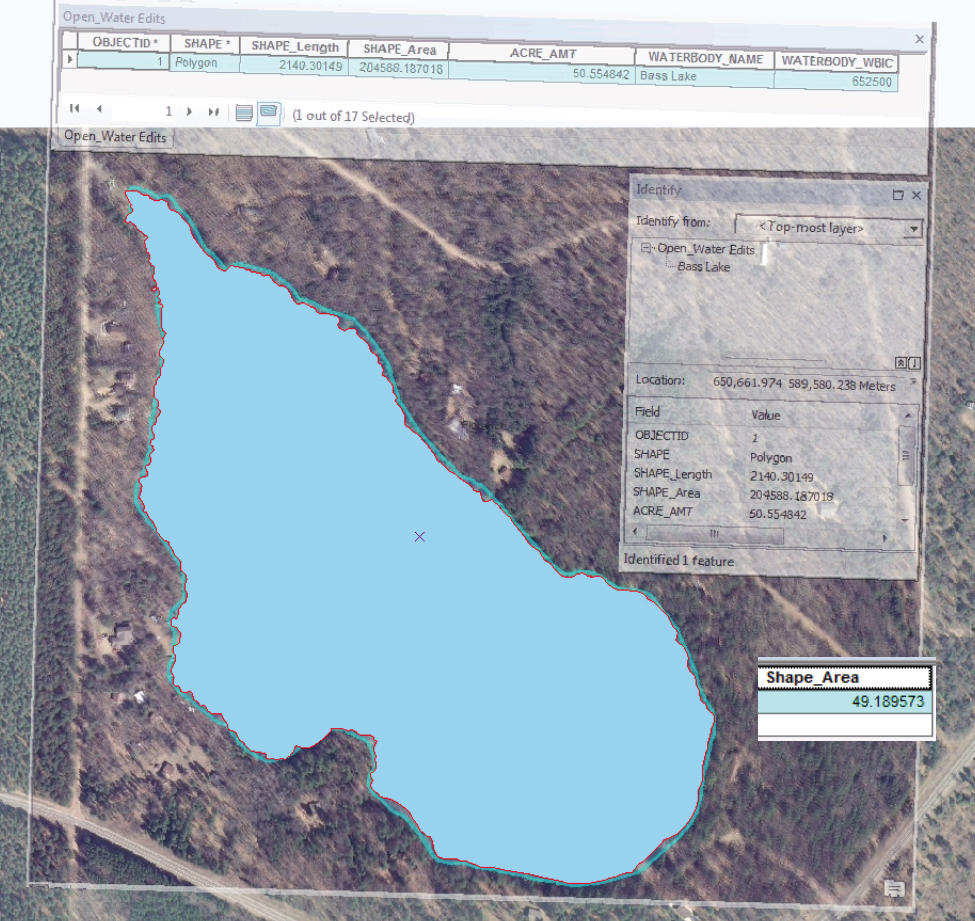
"Boots
on the Ground"
In the spring of 2020, another family member and I paid Cason & Associates to perform a more accurate measure of Bass Lake. Cason
Business manager, Lake Division Manager, and Aquatic
Ecologist Michelle LaForge describes the method as
follows: "The most accurate way to map the
shoreline would be on foot, not using satellite imagery.
Satellite imagery is great for approximations, but if
you are having issues getting the measurements
accepted, boots on the ground is pretty difficult to
argue against. Arguments can be made that satellite
imagery is not geo-referenced correctly (which is true,
there are often projection errors) or that the
current water level is not reflected on the most
recent imagery (age of the imagery, season the imagery
was collected, etc.). Your lake is small enough
that it could easily be completed in a day. That is
what I did for hundreds of state and federal projects.”
Below is an image of Cason’s finding (dated July 15, 2020) which puts the lake’s size at 50.27 acres; this rounds to 50 and re-affirms Bass Lake qualifies for Slow-No-Wake status as it has traditionally. |

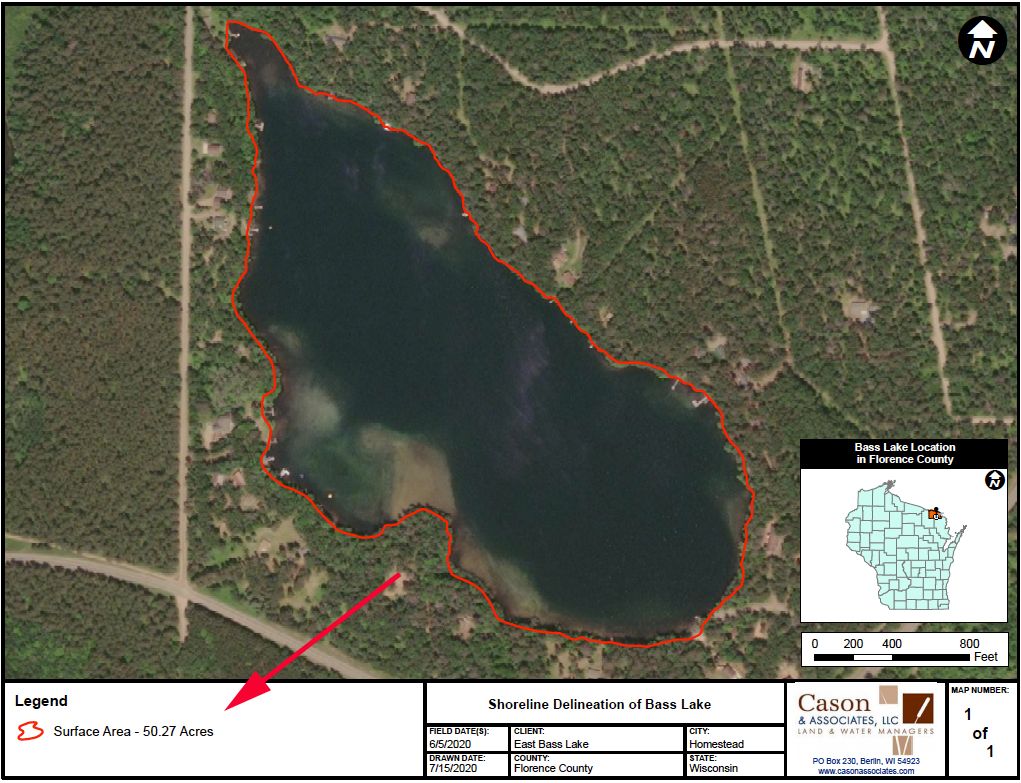
Opinion
My belief is the DNR made an indefensible mistake in 2004 when William G. Engfer, Director, Recreation, Enforcement, and Education Section, Bureau of Law Enforcement sent the letter stating Bass Lake was bigger than 50 acres. That not one DNR employee other than Thomas W. Wrasse (see below) spoke up is disappointing. When I contacted higher DNR levels, rather than do the right thing, Schaal’s Bureau of Water Quality circled the wagons, quickly re-measured, and proclaimed Bass Lake was actually 51 acres so it officially did not qualify as slow-no-wake. The DNR measurement was not only wrong but purposefully inflated. Proof is the fact that two consultants working independently came up with findings just 1/10-acre apart but more than 1.3 acres below the DNR measurement coupled with DNR Conservation Warden Supervisor Thomas W. Wrasse's (now retired) statement from 2004: "We had water regulations and fisheries staff take the stance that this body of water was at best 50 acres, and that was rounded up.” Additional evidence are the DNR’s result, which is barely (suspiciously) enough to round up to 51, and Weise’s plus or minus one-acre inaccuracy. Given the admitted imprecision, shouldn’t an agency once called the “Wisconsin Conservation Department” err on the side of caution and conclude the lake was no bigger than 49.55 acres—which is much closer to its actual size? You might think I’m splitting hairs and 49 acres is barely different from 51 so let the motor boats and jet skis go. Evidently this is what many at the DNR think, but there are reasons for statutes and the time-honored “letter of the law.” The cutoff for slow-no-wake status is 50 acres, Bass Lake is barely bigger than 49 acres, therefore it qualifies as a slow-no-wake lake. One of the DNR wardens I spoke with actually said, “Well, it’s like giving drivers leeway on the road; you don’t write a ticket for going 50 in a 45 zone.” Sounded good—to him at least—until I asked if he thinks the DNR should practice the same leniency, for example, with trout bag limits? “Well, that’s different.” Indeed, and so is slow-no-wake. |
* * *
| Though Bass Lake is 50 acres in overall size, as confirmed by Cason's June of 2020 "boots on the ground" measure, the aerial below makes it clear the expanse of water in the basin deep enough for motor boating is much smaller. |
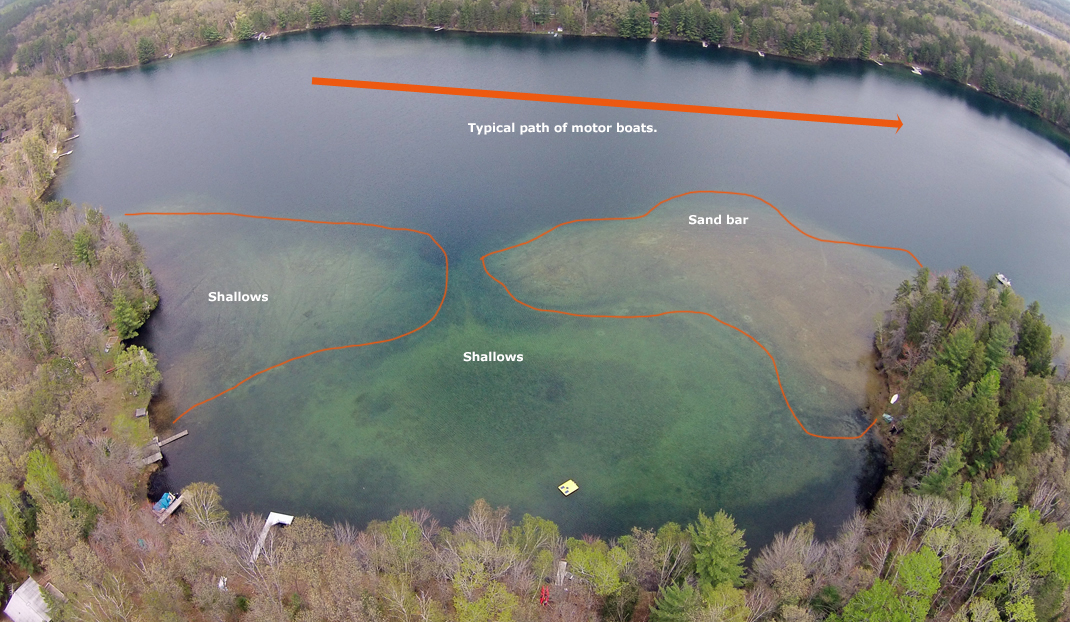
Consequences
| Over
time,
jet skis and motor boats coupled with continually
expanding population will change the character of this
Land of Sky Blue Waters lake; that’s a shame, and I blame
it on the DNR. Its actions, powered by incompetence,
malfeasance, some of both, or something I haven’t thought
of, are encouraging the ruin of a fragile ecosystem. The lake just isn't large enough to absorb the mechanical-combustion-engine pressure—this is particularly evident on holiday weekends throughout the summer. The excerpts below were taken from an article that cites a Wisconsin DNR study. I found it (ironically) on a Minnesota website (https://www.rmbel.info/boat-motors-and-water-quality/): "The Wisconsin DNR did a study on the effects of motorized watercraft on aquatic ecosystems. Boats can affect water quality in a few different aspects. First, they can add metals and chemicals to the water column. A certain amount of the fuel that enters into a motor is discharged unburned and ends up in the water. Two stroke motors can emit 25-30% of their unburned gas and oil mixture into the water. In contrast, four-stroke motors emit 97% less air and water pollution than old two-stroke motors. This pollution can affect the pH and dissolved oxygen in the lake, which can influence the type and abundance of fish and wildlife." |
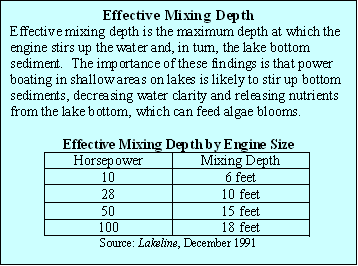
| "Another
main impact by motors is churning up the lake bottom in
shallow areas. This action stirs up the lake sediment,
re-suspending nutrients (phosphorus) that are at the
lake’s bottom. When these nutrients reach the surface of
the water where the algae are, they can feed algae and
cause and algal bloom. This stirring can also decrease the
water clarity because of additional particles suspended in
the water column. "So what can you do to protect your lake? 1) Establish no-wake zones in shallow areas with waterfowl nesting and bulrush stands. 'Slow no wake' means operation of a watercraft at the slowest possible speed necessary to maintain steerage, but in no case greater than 5 miles per hour. 2) Educate lake users to avoid sensitive areas and drive slowly through shallow areas. 3) Upgrade your boat motor from an old two-stroke engine to a four-stroke engine. Four-stroke engines use fuel more efficiently, produce cleaner exhaust, and run more quietly than traditional two-stroke engines." Click for the entire Wisconsin DNR study. In addition, fast-moving craft on Bass Lake are a grave danger to loons and other water fowl in my opinion. |
|
Returning Slow-No-Wake to Bass Lake After scheduling
and attending two meetings in Madison with DNR
personnel, including April Dombrowski and Carroll
Schaal, in 2015 and 2016, and presenting PowerPoints
and details of the consultants’ measurements, and not
making any progress, I gave up, began searching for
legal help, and became a client of the Madison law
firm Pines Bach in 2017. The attorney I worked
with reviewed the Bass Lake situation carefully and
filed a freedom of information request with the
DNR.
Unfortunately, but not surprisingly, I learned that the cards are stacked in favor of the DNR. Accusing it of incompetence, malfeasance, negligence, etc. and taking it to court likely would cost a minimum of $50,000 with no guarantee of success. Just having an expert research options was expensive. It's a frustrating situation made worse because not all agree slow-no-wake should be returned to Bass Lake, including members of my own family. If you like motor boating, it's convenient to walk down to the dock, get aboard, and go. However, it doesn’t seem all that burdensome to travel 10 miles to Hilbert Lake just off Highway 101—its 278 acres make it more able to absorb high speed traffic than Bass Lake. Whenever the challenge of righting this wrong gets me down, I think about the defenseless ecosystem and its future. Who will speak for and defend Bass Lake when its statutory, government protector doesn't? Then, I think, I will…or, at least, I'll try. It's been good to me, and I'd like to return the favor. If you would like to see slow-no-wake restored to Bass Lake, please let me know. If enough of us band together and put pressure on the DNR, perhaps we can persuade it to re-measure the lake—this time with the goal of achieving an accurate, no thumb-on-the-scale result. Write to me at ted@tswrites.com or call 414 795-6117 (I only answer calls from people on my contact list, so please leave a message). |
